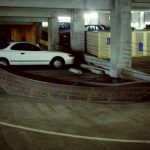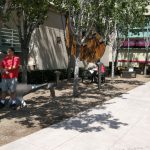K O L L A N A H E I M C E N T E R A R T I N P U B L I C P L A C E S, Anaheim, California, 1990-1992
Commissioner: Anaheim Redevelopment Agency
Consultants: David Berksen, Landscape Architect, SWA Group, Mary Miss, Artist, Mark Pally, Artist
Artist Team: Daniel Martinez, Nobuho Nagasawa, Buster Simpson
Award: Outstanding Community Support of Art in Public Places Recognition Award, 1993 and Art in Public Places Award, 1995
The Koll Anaheim Center is a three block long urban complex, across from Anaheim City Hall, in downtown Anaheim, California. The project consisted of a series of public artworks for the $ 200 million retail and business development of Anaheim Center. The artist team conceived of the overall streetscape concept together, but each produced artwork individually. The site-specific components, including street furniture and free standing sculpture, recall the agricultural, historical, industrial, cultural, and natural heritage of Anaheim. The project received Koll Anaheim Center Recognition of Outstanding Community Support of Art in Public Places Award in 1993, and Art in Public Places Award from the Architecture Foundation of Orange County in 1995.
S i n k i n g C a n o e steel, light projector
The first known humans to live in the Anaheim region were present at least twenty thousand years ago but little evidence of their life remains. More recently, in approximately 2,000 B.C., the Gabrielinos and Juanenos tribes settled in the coastal plains of the area. The Gabrielinos were the only native North Americans to use planks in constructing their canoes. Sinking Canoe evokes this early form of transportation. The lights projected from the canoe onto the ceiling above are based on Gabrielino symbols an iconography. Caught sinking into the parking stall, the viewers encounters the canoe unexpectedly, in a meeting that is at once absurd, comical, and meaningful.
P l a n t e r s cast concrete, pigment 2.4 x 4 x 4’
The patterns and symbols of the three cast concrete planters are adapted from Gabrielino motifs frequently seen in their extremely sophisticated baskets. Plants native to Southern California grow in the planters.
C o y o t e B e n c h cast concrete, boulders 1.6 x 13 x 3’
The coyote is one of the most tenacious animals living in Southern California. It has adapted well to the intrusion of man, easily surviving on discarded food instead of hunting in the wild. Native Americans in earlier times gave coyotes great respect, commemorating them in a story revealed in Coyote Bench. YTUR is the approximate phonetic pronunciation of the Gabrielino word for coyote. The bench itself is rough, closer to raw and natural materials than those usually encountered in urban settings. Its exposed rocks come directly from the earth, but are also embedded in concrete, a material used widely in city and building construction. Therefore the bench is also a reminder of the complex relationship between civilization and the natural world. Coyote’s footprint is sandblasted in the sidewalk.
A n v i l a n d N a i l s a n d S i d e w a l k T e x t stainless steel, sandblasted text 1.6 x 5 x 1’
In the nineteen century, Pressel’s General Blacksmithing and Horse Shoeing business was located in downtown Anaheim. Anvil and Nails pays homage to that era. A sandblasted quote on the nearby sidewalk is taken from a San Francisco newspaper from 1858. It reports a visitor’s impression of Anaheim as a highly industrious place. Downtown Anaheim has been a site of labor since its earliest days. The agricultural businesses have been replaced with white-collar jobs, but the area’s dedication to work remains.
O r a n g e C r a t e s recycled redwood, porcelain enamel
Orange Crates are situated next to a tree with individual boxes scattered about the ground in a casual manner, offering a place to sit down. Real orange crates were filled with Anaheim’s agricultural bounty and shipped to destinations all across the country, from Orange County, Anaheim. Authentic labels, including the “Pride of Anaheim,” have been accurately reproduced and demonstrate the beauty of an art form no longer practiced.
T r e e G r a t e cast aluminum 2” x 6 x 6’
The tree grate design is based on a map of the original city boundaries, as divided by the North, South, East, and West Streets. A patch below the north arrow shows the location of the last orange grove of Anaheim, no longer in existence. As the trees grow, nature invades the urban landscape again.








